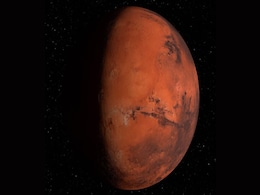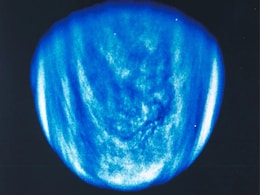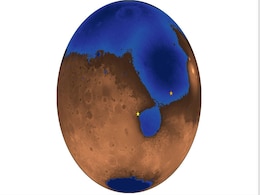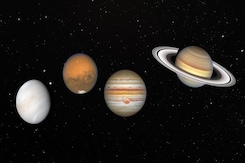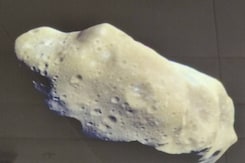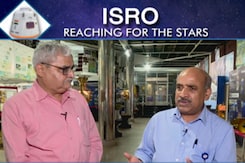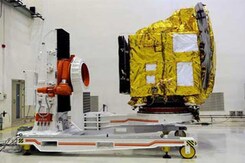Planetary
- All
- News
- Videos
- Web Stories
-

JWST Captures Unseen Details of Exoplanets in HR 8799 and 51 Eridani Systems
- Thursday April 3, 2025
- Written by Gadgets 360 Staff
The James Webb Space Telescope (JWST) has captured groundbreaking images of exoplanets in the HR 8799 and 51 Eridani systems. By modifying its coronagraphs, astronomers allowed more starlight to pass through, revealing clearer planetary details. The study, published in The Astrophysical Journal Letters, highlights the first successful detection of ...
-
 www.gadgets360.com
www.gadgets360.com
-

Two New Exoplanets Found Orbiting a Star in Draco Constellation
- Wednesday April 2, 2025
- Written by Gadgets 360 Staff
Astronomers have identified two exoplanets, TOI-1453 b and TOI-1453 c, orbiting a star 250 light-years away in Draco. The planets, a super-Earth and a sub-Neptune, were detected using NASA’s TESS satellite and the HARPS-N spectrograph. TOI-1453 b is a rocky planet orbiting close to its star, while TOI-1453 c is twice Earth’s size and may have a...
-
 www.gadgets360.com
www.gadgets360.com
-

James Webb Telescope Captures Neptune’s Auroras in Stunning Detail
- Monday March 31, 2025
- Written by Gadgets 360 Staff
The James Webb Space Telescope has provided the first-ever direct images of Neptune’s auroras, revealing surprising details about the ice giant’s atmosphere. Unlike auroras on Earth, Jupiter, or Saturn, Neptune’s auroras appear across unexpected locations due to its tilted and offset magnetic field. Scientists also detected the presence of H...
-
 www.gadgets360.com
www.gadgets360.com
-

New Study Challenges Claims of Vast Underground Water on Mars
- Thursday March 27, 2025
- Written by Gadgets 360 Staff
Mars’ water history remains a mystery as new research questions the claim that vast amounts of water are stored beneath its surface. A study led by Bruce Jakosky argues that previous estimates of Mars’ mid-crust being saturated with liquid water may be inaccurate. The findings challenge earlier interpretations of seismic data from NASA’s InSi...
-
 www.gadgets360.com
www.gadgets360.com
-

NASA’s EZIE Satellites Begin Mission to Study Auroral Electrojets and Space Weather
- Friday March 21, 2025
- Written by Gadgets 360 Staff
NASA’s Electrojet Zeeman Imaging Explorer (EZIE) mission has been launched aboard a SpaceX Falcon 9 from Vandenberg Space Force Base. The trio of small satellites will map auroral electrojets, powerful currents in Earth’s atmosphere linked to solar storms. Their data will enhance space weather prediction models and help understand planetary mag...
-
 www.gadgets360.com
www.gadgets360.com
-

3D Mapping Reveals 52-Foot Megaripples from Chicxulub Asteroid in Louisiana
- Thursday March 13, 2025
- Written by Gadgets 360 Staff
Massive megaripples, formed by the tsunami after the Chicxulub asteroid impact 66 million years ago, have been mapped deep beneath Louisiana using 3D seismic data. The formations, averaging 52 feet in height and spanning 900 square miles, offer new insights into the force of the ancient tsunami and its global impact. Scientists suggest these findin...
-
 www.gadgets360.com
www.gadgets360.com
-

Mysterious Planetary-Mass Objects May Form in Young Star System Clashes
- Wednesday March 12, 2025
- Written by Gadgets 360 Staff
Recent research challenges traditional views on planetary-mass objects, suggesting they may form through violent interactions between young star systems rather than standard planetary or stellar processes. Simulations indicate these clashes create dense gas filaments that evolve into free-floating objects, often in binary pairs. This discovery expl...
-
 www.gadgets360.com
www.gadgets360.com
-

X-ray Signal from Helix Nebula Suggests Planet Was Destroyed by White Dwarf
- Thursday March 6, 2025
- Written by Gadgets 360 Staff
Astronomers have traced decades-old X-ray emissions from the Helix Nebula to a white dwarf possibly consuming planetary debris. Reports suggest a Jupiter-like planet may have been torn apart by the star’s intense gravitational forces. Data from NASA’s Chandra X-ray Observatory and ESA’s XMM-Newton indicate that remnants of the destroyed plane...
-
 www.gadgets360.com
www.gadgets360.com
-

Private Venus Mission Plans to Retrieve Cloud Samples for Life Research
- Thursday March 6, 2025
- Written by Gadgets 360 Staff
A privately-led space mission is being developed to retrieve and analyse cloud samples from Venus. Scientists believe the planet’s sulfuric acid clouds might sustain organic molecules necessary for life. The mission, named Morning Star, involves deploying probes to collect mist from Venus' atmosphere. The collected samples would be returned to Ea...
-
 www.gadgets360.com
www.gadgets360.com
-

Primordial Helium-3 May Be Locked in Earth’s Core, Study Finds
- Wednesday March 5, 2025
- Written by Gadgets 360 Staff
Helium-3, an isotope formed during the solar system's birth, may be trapped in Earth's core, a study suggests. Researchers at the University of Tokyo found that helium can mix with iron at extreme heat and pressure, allowing it to remain in Earth's solid core. This discovery could help determine how quickly the planet formed, with a rapid formation...
-
 www.gadgets360.com
www.gadgets360.com
-

Planetary Parade 2025: Rare Photo Captures Earth And 7 Planets For The First Time Ever
- Thursday February 27, 2025
- Science | Edited by Ritu Singh
Experts have claimed it could be the first time all planets including Earth have been captured in a single image.
-
 www.ndtv.com
www.ndtv.com
-

Ancient Martian Ocean Shoreline Discovered Beneath Surface by Zhurong Rover
- Monday March 3, 2025
- Written by Gadgets 360 Staff
China's Zhurong rover has uncovered evidence of an ancient ocean on Mars, with ground-penetrating radar detecting a buried shoreline beneath the Utopia Basin. The rover’s scans revealed sloping sand layers similar to those found on Earth’s beaches, reinforcing theories of long-term water presence. Experts highlight that these formations are not...
-
 www.gadgets360.com
www.gadgets360.com
-

NASA Partners With SpaceX To Launch NEO Surveyor, a Mission To Detect Asteroid Threats
- Friday February 28, 2025
- Written by Gadgets 360 Staff
NASA has selected SpaceX for the launch of its NEO Surveyor spacecraft in 2027. The mission, valued at $100 million, will use a Falcon 9 rocket to deploy the spacecraft to the Sun-Earth Lagrange Point 1. The infrared telescope will help detect and track hazardous near-Earth objects, including difficult-to-spot dark asteroids. This mission builds on...
-
 www.gadgets360.com
www.gadgets360.com
-

Hubble Captures Stunning Tarantula Nebula Image, Revealing Cosmic Dust and Star Formation
- Thursday February 27, 2025
- Written by Gadgets 360 Staff
A new image from the Hubble Space Telescope highlights the Tarantula Nebula’s complex structure, featuring dense cosmic dust clouds and vibrant star-forming regions. This nebula, located 160,000 light-years away, plays a vital role in understanding stellar evolution. The captured details offer insights into how cosmic dust contributes to star and...
-
 www.gadgets360.com
www.gadgets360.com
-

New Study Challenges Great Filter Theory, Suggests Life Evolves with Planetary Changes
- Monday February 24, 2025
- Written by Gadgets 360 Staff
A recent study argues that intelligent life does not emerge by sheer luck but evolves when planetary conditions become suitable. Researchers challenge the "great filter" concept, suggesting that Earth's changing geobiology influenced when life arose rather than a series of improbable events. This perspective shifts the focus to how planetary enviro...
-
 www.gadgets360.com
www.gadgets360.com
-

JWST Captures Unseen Details of Exoplanets in HR 8799 and 51 Eridani Systems
- Thursday April 3, 2025
- Written by Gadgets 360 Staff
The James Webb Space Telescope (JWST) has captured groundbreaking images of exoplanets in the HR 8799 and 51 Eridani systems. By modifying its coronagraphs, astronomers allowed more starlight to pass through, revealing clearer planetary details. The study, published in The Astrophysical Journal Letters, highlights the first successful detection of ...
-
 www.gadgets360.com
www.gadgets360.com
-

Two New Exoplanets Found Orbiting a Star in Draco Constellation
- Wednesday April 2, 2025
- Written by Gadgets 360 Staff
Astronomers have identified two exoplanets, TOI-1453 b and TOI-1453 c, orbiting a star 250 light-years away in Draco. The planets, a super-Earth and a sub-Neptune, were detected using NASA’s TESS satellite and the HARPS-N spectrograph. TOI-1453 b is a rocky planet orbiting close to its star, while TOI-1453 c is twice Earth’s size and may have a...
-
 www.gadgets360.com
www.gadgets360.com
-

James Webb Telescope Captures Neptune’s Auroras in Stunning Detail
- Monday March 31, 2025
- Written by Gadgets 360 Staff
The James Webb Space Telescope has provided the first-ever direct images of Neptune’s auroras, revealing surprising details about the ice giant’s atmosphere. Unlike auroras on Earth, Jupiter, or Saturn, Neptune’s auroras appear across unexpected locations due to its tilted and offset magnetic field. Scientists also detected the presence of H...
-
 www.gadgets360.com
www.gadgets360.com
-

New Study Challenges Claims of Vast Underground Water on Mars
- Thursday March 27, 2025
- Written by Gadgets 360 Staff
Mars’ water history remains a mystery as new research questions the claim that vast amounts of water are stored beneath its surface. A study led by Bruce Jakosky argues that previous estimates of Mars’ mid-crust being saturated with liquid water may be inaccurate. The findings challenge earlier interpretations of seismic data from NASA’s InSi...
-
 www.gadgets360.com
www.gadgets360.com
-

NASA’s EZIE Satellites Begin Mission to Study Auroral Electrojets and Space Weather
- Friday March 21, 2025
- Written by Gadgets 360 Staff
NASA’s Electrojet Zeeman Imaging Explorer (EZIE) mission has been launched aboard a SpaceX Falcon 9 from Vandenberg Space Force Base. The trio of small satellites will map auroral electrojets, powerful currents in Earth’s atmosphere linked to solar storms. Their data will enhance space weather prediction models and help understand planetary mag...
-
 www.gadgets360.com
www.gadgets360.com
-

3D Mapping Reveals 52-Foot Megaripples from Chicxulub Asteroid in Louisiana
- Thursday March 13, 2025
- Written by Gadgets 360 Staff
Massive megaripples, formed by the tsunami after the Chicxulub asteroid impact 66 million years ago, have been mapped deep beneath Louisiana using 3D seismic data. The formations, averaging 52 feet in height and spanning 900 square miles, offer new insights into the force of the ancient tsunami and its global impact. Scientists suggest these findin...
-
 www.gadgets360.com
www.gadgets360.com
-

Mysterious Planetary-Mass Objects May Form in Young Star System Clashes
- Wednesday March 12, 2025
- Written by Gadgets 360 Staff
Recent research challenges traditional views on planetary-mass objects, suggesting they may form through violent interactions between young star systems rather than standard planetary or stellar processes. Simulations indicate these clashes create dense gas filaments that evolve into free-floating objects, often in binary pairs. This discovery expl...
-
 www.gadgets360.com
www.gadgets360.com
-

X-ray Signal from Helix Nebula Suggests Planet Was Destroyed by White Dwarf
- Thursday March 6, 2025
- Written by Gadgets 360 Staff
Astronomers have traced decades-old X-ray emissions from the Helix Nebula to a white dwarf possibly consuming planetary debris. Reports suggest a Jupiter-like planet may have been torn apart by the star’s intense gravitational forces. Data from NASA’s Chandra X-ray Observatory and ESA’s XMM-Newton indicate that remnants of the destroyed plane...
-
 www.gadgets360.com
www.gadgets360.com
-

Private Venus Mission Plans to Retrieve Cloud Samples for Life Research
- Thursday March 6, 2025
- Written by Gadgets 360 Staff
A privately-led space mission is being developed to retrieve and analyse cloud samples from Venus. Scientists believe the planet’s sulfuric acid clouds might sustain organic molecules necessary for life. The mission, named Morning Star, involves deploying probes to collect mist from Venus' atmosphere. The collected samples would be returned to Ea...
-
 www.gadgets360.com
www.gadgets360.com
-

Primordial Helium-3 May Be Locked in Earth’s Core, Study Finds
- Wednesday March 5, 2025
- Written by Gadgets 360 Staff
Helium-3, an isotope formed during the solar system's birth, may be trapped in Earth's core, a study suggests. Researchers at the University of Tokyo found that helium can mix with iron at extreme heat and pressure, allowing it to remain in Earth's solid core. This discovery could help determine how quickly the planet formed, with a rapid formation...
-
 www.gadgets360.com
www.gadgets360.com
-

Planetary Parade 2025: Rare Photo Captures Earth And 7 Planets For The First Time Ever
- Thursday February 27, 2025
- Science | Edited by Ritu Singh
Experts have claimed it could be the first time all planets including Earth have been captured in a single image.
-
 www.ndtv.com
www.ndtv.com
-

Ancient Martian Ocean Shoreline Discovered Beneath Surface by Zhurong Rover
- Monday March 3, 2025
- Written by Gadgets 360 Staff
China's Zhurong rover has uncovered evidence of an ancient ocean on Mars, with ground-penetrating radar detecting a buried shoreline beneath the Utopia Basin. The rover’s scans revealed sloping sand layers similar to those found on Earth’s beaches, reinforcing theories of long-term water presence. Experts highlight that these formations are not...
-
 www.gadgets360.com
www.gadgets360.com
-

NASA Partners With SpaceX To Launch NEO Surveyor, a Mission To Detect Asteroid Threats
- Friday February 28, 2025
- Written by Gadgets 360 Staff
NASA has selected SpaceX for the launch of its NEO Surveyor spacecraft in 2027. The mission, valued at $100 million, will use a Falcon 9 rocket to deploy the spacecraft to the Sun-Earth Lagrange Point 1. The infrared telescope will help detect and track hazardous near-Earth objects, including difficult-to-spot dark asteroids. This mission builds on...
-
 www.gadgets360.com
www.gadgets360.com
-

Hubble Captures Stunning Tarantula Nebula Image, Revealing Cosmic Dust and Star Formation
- Thursday February 27, 2025
- Written by Gadgets 360 Staff
A new image from the Hubble Space Telescope highlights the Tarantula Nebula’s complex structure, featuring dense cosmic dust clouds and vibrant star-forming regions. This nebula, located 160,000 light-years away, plays a vital role in understanding stellar evolution. The captured details offer insights into how cosmic dust contributes to star and...
-
 www.gadgets360.com
www.gadgets360.com
-

New Study Challenges Great Filter Theory, Suggests Life Evolves with Planetary Changes
- Monday February 24, 2025
- Written by Gadgets 360 Staff
A recent study argues that intelligent life does not emerge by sheer luck but evolves when planetary conditions become suitable. Researchers challenge the "great filter" concept, suggesting that Earth's changing geobiology influenced when life arose rather than a series of improbable events. This perspective shifts the focus to how planetary enviro...
-
 www.gadgets360.com
www.gadgets360.com




